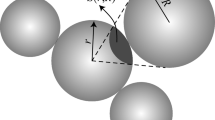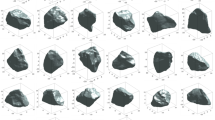Abstract
A method is proposed to calculate the distribution of energy during the quasi-static confined comminution of particulate assemblies. The work input, calculated by integrating the load-displacement curve, is written as the sum of the elastic deformation energy, the breakage energy and the redistribution energy. Experimental results obtained on samples subjected to compression stresses ranging between 0.4 and 92 MPa are used to calibrate the model. The elastic energy stored in the samples is obtained by simulating the compression test on the final particle size distributions (PSDs) with the discrete element method and by extracting the contact forces. A PSD evolution law is proposed to account for particle breakage. The PSD is related to the total particle surface in the sample, which allows calculating the breakage energy. The redistribution energy, which comprises the kinetic energy of particles being rearranged and the friction energy dissipated at contacts, is obtained by subtracting the elastic energy and breakage energy from the work input. Results show that: (1) at least 60% of the work input is dissipated by particle redistribution; (2) the fraction of elastic deformation energy increases, and the fraction of redistribution energy decreases as the compression stress increases; (3) the breakage energy accounts for less than 5% of the total input energy, and this value is independent of the compressive stress; (4) the energy dissipated by redistribution is between 14 and 30 times larger than the breakage energy.






Similar content being viewed by others
References
Abe S, Mair K (2005) Grain fracture in 3D numerical simulations of granular shear. Geophys Res Lett 32(5):1–4
Afshar T, Disfani MM, Arulrajah A, Narsilio GA, Emam S (2017) Impact of particle shape on breakage of recycled construction and demolition aggregates. Powder Technol 308:1–12
Arsalan N, Palayangoda SS, Burnett DJ, Buiting JJ, Nguyen QP (2013) Surface energy characterization of sandstone rocks. J Phys Chem Solids 74(8):1069–1077
ASTM (2016) Standard test methods for fineness of hydraulic cement by air-permeability apparatus. ASTM International, West Conshohocken, PA ASTM C204
Bolton M, Nakata Y, Cheng Y (2008) Micro-and macro-mechanical behaviour of dem crushable materials. Geotechnique 58(6):471–480
Chan S, Ngan A (2005) Statistical distribution of contact forces in packings of deformable spheres. Mech Mater 37(4):493–506
Ciantia MO, Arroyo M, Calvetti F, Gens A (2016) A numerical investigation of the incremental behavior of crushable granular soils. Int J Numer Anal Methods Geomech 40(13):1773–1798
Collins I, Houlsby G (1997) Application of thermomechanical principles to the modelling of geotechnical materials. Proc R Soc Lond A Methods Phys Eng Sci 453:1975–2001
Collins IF (2005) The concept of stored plastic work or frozen elastic energy in soil mechanics. Geotechnique 55(5):373–382
Coop M, Sorensen K, Freitas TB, Georgoutsos G (2004) Particle breakage during shearing of a carbonate sand. Géotechnique 54(3):157–163
Das A, Tengattini A, Nguyen G, Einav I (2013) A micromechanics based model for cemented granular materials. In: Yang Q, Zhang J-M, Zheng H, Yao Y (eds) Constitutive modeling of geomaterials: advances and new applications. Springer, Berlin, Heidelberg, pp 527–534. https://doi.org/10.1007/978-3-642-32814-5_71
Einav I (2007a) Breakage mechanics—part II: modelling granular materials. J Mech Phys Solids 55(6):1298–1320
Einav I (2007b) Breakage mechanics—part I: theory. J Mech Phys Solids 55(6):1274–1297
Friedman M, Handin J, Alani G (1972) Fracture-surface energy of rocks. Int J Rock Mech Min Sci Geomech Abstr 9:757–764
Griffith AA (1921) The phenomena of rupture and flow in solids. Philos Trans R Soc Lond A Contain Pap Math Phys Character 221:163–198
Hardin BO (1985) Crushing of soil particles. J Geotech Eng 111(10):1177–1192
Itasca (2008) Particle flow code in two dimensions, version 4.0. Itasca Consulting Group, Inc., Minnesota
Jefferies M (1997) Plastic work and isotropic softening in unloading. Géotechnique 47(5):1037–1042
Jiang M, Chen H, Crosta GB (2015) Numerical modeling of rock mechanical behavior and fracture propagation by a new bond contact model. Int J Rock Mech Min Sci 78:175–189
Lade PV, Yamamuro JA, Bopp PA (1996) Significance of particle crushing in granular materials. J Geotech Eng 122(4):309–316
Li Z, Wang YH, Ma C, Mok C (2017) Experimental characterization and 3d dem simulation of bond breakages in artificially cemented sands with different bond strengths when subjected to triaxial shearing. Acta Geotech 12(5):987–1002
McDowell G (2002) On the yielding and plastic compression of sand. Soils Found 42(1):139–145
McDowell G, Bolton M, Robertson D (1996) The fractal crushing of granular materials. J Mech Phys Solids 44(12):2079–2101
Meng J, Huang J, Sheng D, Sloan S (2017) Granular contact dynamics with elastic bond model. Acta Geotech 12(3):479–493
Miura N, O-HARA S (1979) Particle-crushing of a decomposed granite soil under shear stresses. Soils Found 19(3):1–14
Miura N, Yamamoto T (1976) Particle-crushing properties of sands under high stresses. Technol Rep Yamaguchi Univ 1(4):439–447
Nakata Y, Hyodo M, Hyde AF, Kato Y, Murata H (2001a) Microscopic particle crushing of sand subjected to high pressure one-dimensional compression. Soils Found 41(1):69–82
Nakata Y, Kato Y, Hyodo M, HYDE AF, Murata H (2001b) One-dimensional compression behaviour of uniformly graded sand related to single particle crushing strength. Soils Found 41(2):39–51
Nguyen GD, Einav I (2009) The energetics of cataclasis based on breakage mechanics. Pure Appl Geophys 166(10–11):1693–1724. https://doi.org/10.1007/s00024-009-0518-x
Ovalle C, Dano C, Hicher PY (2013) Experimental data highlighting the role of surface fracture energy in quasi-static confined comminution. Int J Fract 182(1):123–130
Ovalle C, Voivret C, Dano C, Hicher PY (2016) Population balance in confined comminution using a physically based probabilistic approach for polydisperse granular materials. Int J Numer Anal Methods Geomech 40(17):2383–2397
Parks GA (1984) Surface and interfacial free energies of quartz. J Geophys Res Solid Earth 89(B6):3997–4008
Peters J, Muthuswamy M, Wibowo J, Tordesillas A (2005) Characterization of force chains in granular material. Phys Rev E 72(4):041,307
Radjai F, Jean M, Moreau JJ, Roux S (1996) Force distributions in dense two-dimensional granular systems. Phys Rev Lett 77(2):274
Roscoe K, Schofield A, Thurairajah A (1963) Yielding of clays in states wetter than critical. Geotechnique 13(3):211–240
Russell A (2011) A compression line for soils with evolving particle and pore size distributions due to particle crushing. Géotech Lett 1(1):5–9
Russell AR, Einav I (2013) Energy dissipation from particulate systems undergoing a single particle crushing event. Granul Matter 15(3):299–314
Sammis C, King G, Biegel R (1987) The kinematics of gouge deformation. Pure Appl Geophys 125(5):777–812
Semnani SJ, White JA, Borja RI (2016) Thermoplasticity and strain localization in transversely isotropic materials based on anisotropic critical state plasticity. Int J Numer Anal Methods Geomech 40(18):2423–2449
Tarantino A, Hyde AF (2005) An experimental investigation of work dissipation in crushable materials. Géotechnique 55(8):575–584
Taylor HF (1997) Cement chemistry. Thomas Telford, London
Tjioe M, Borja RI (2015) On the pore-scale mechanisms leading to brittle and ductile deformation behavior of crystalline rocks. Int J Numer Anal Methods Geomech 39(11):1165–1187
Tjioe M, Borja RI (2016) Pore-scale modeling of deformation and shear band bifurcation in porous crystalline rocks. Int J Numer Methods Eng 108(3):183–212
Turcotte D (1986) Fractals and fragmentation. J Geophys Res Solid Earth 91(B2):1921–1926
Tyler SW, Wheatcraft SW (1992) Fractal scaling of soil particle-size distributions: analysis and limitations. Soil Sci Soc Am J 56(2):362–369
Utili S, Nova R (2008) Dem analysis of bonded granular geomaterials. Int J Numer Anal Methods Geomech 32(17):1997–2031
Wang J, Yan H (2012) Dem analysis of energy dissipation in crushable soils. Soils Found 52(4):644–657
Wang P, Arson C (2016) Discrete element modeling of shielding and size effects during single particle crushing. Comput Geotech 78:227–236
Wang P, Arson C et al (2016) Breakage mechanics modeling of the brittle-ductile transition in granular materials. In: 50th US rock mechanics/geomechanics symposium. American Rock Mechanics Association
Zhang J, Majmudar T, Tordesillas A, Behringer R (2010) Statistical properties of a 2D granular material subjected to cyclic shear. Granul Matter 12(2):159–172
Zhang S, Tong C, Li X, Sheng D (2015) A new method for studying the evolution of particle breakage. Géotechnique 65(11):911–922
Zhang YD, Buscarnera G (2017) A rate-dependent breakage model based on the kinetics of crack growth at the grain scale. Geotechnique 67(11):953–967
Zhao B, Wang J, Coop M, Viggiani G, Jiang M (2015) An investigation of single sand particle fracture using X-ray micro-tomography. Géotechnique 65(8):625–641
Author information
Authors and Affiliations
Corresponding author
Rights and permissions
About this article
Cite this article
Wang, P., Arson, C. Energy distribution during the quasi-static confined comminution of granular materials. Acta Geotech. 13, 1075–1083 (2018). https://doi.org/10.1007/s11440-017-0622-5
Received:
Accepted:
Published:
Issue Date:
DOI: https://doi.org/10.1007/s11440-017-0622-5




